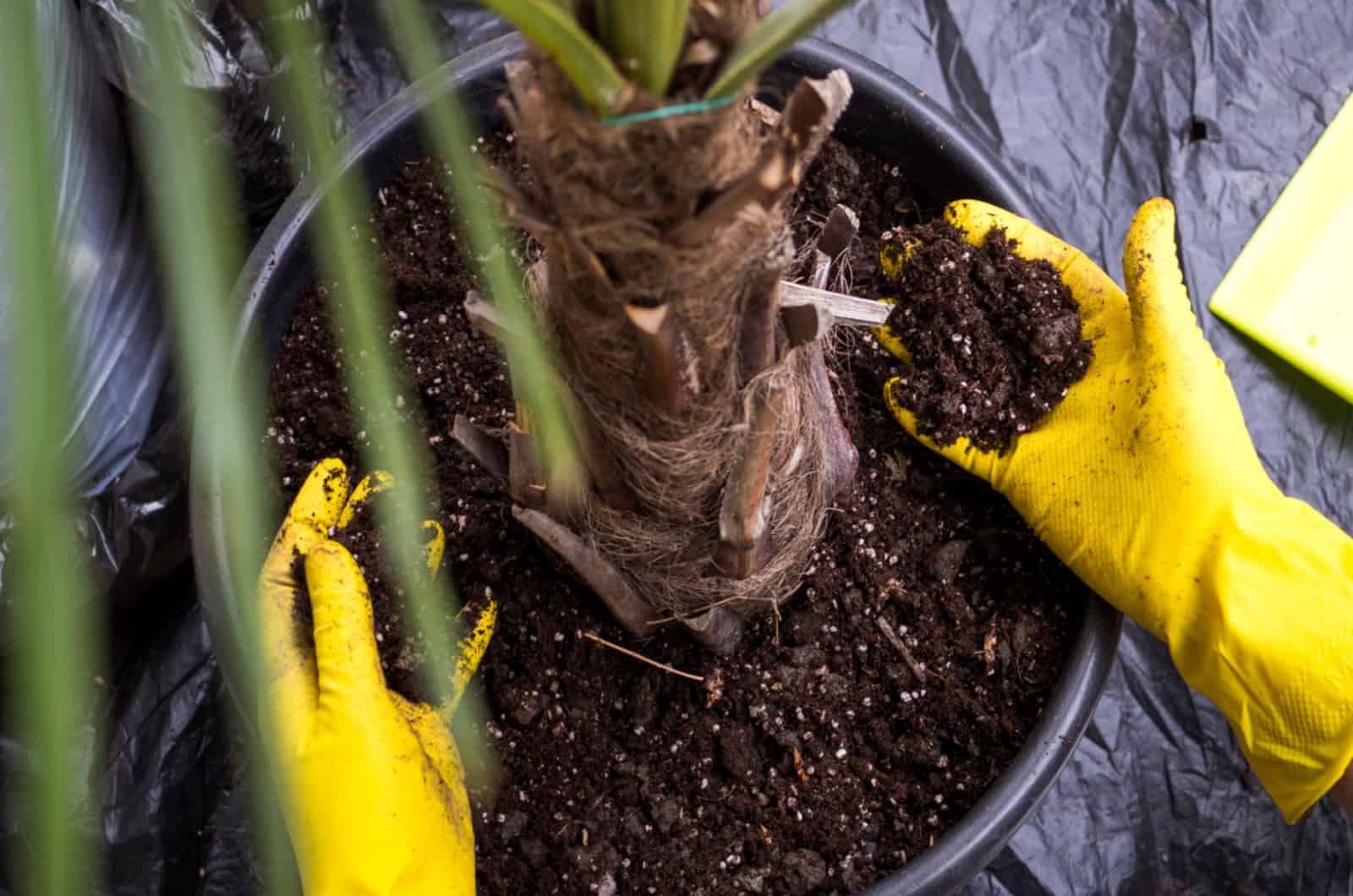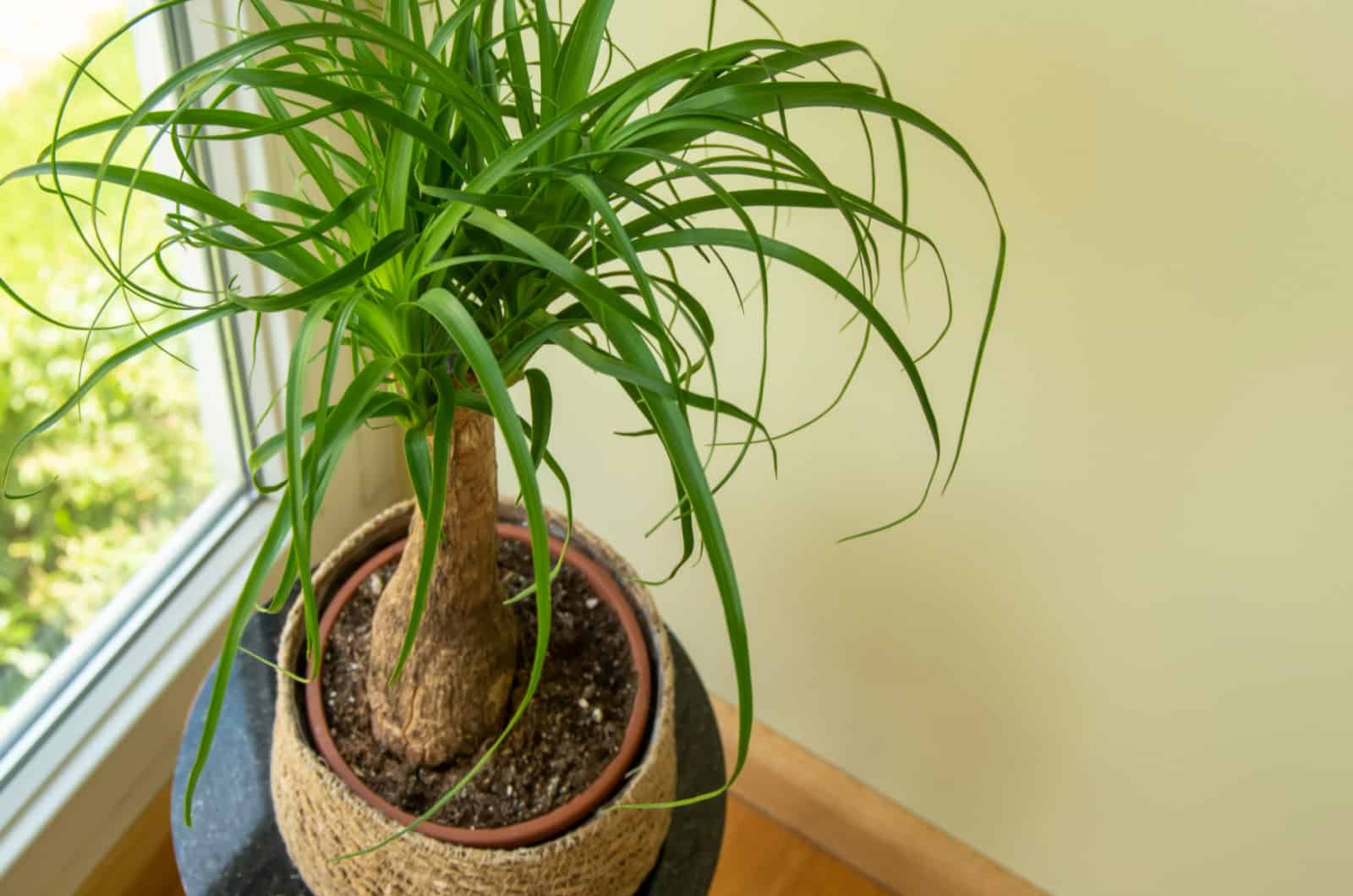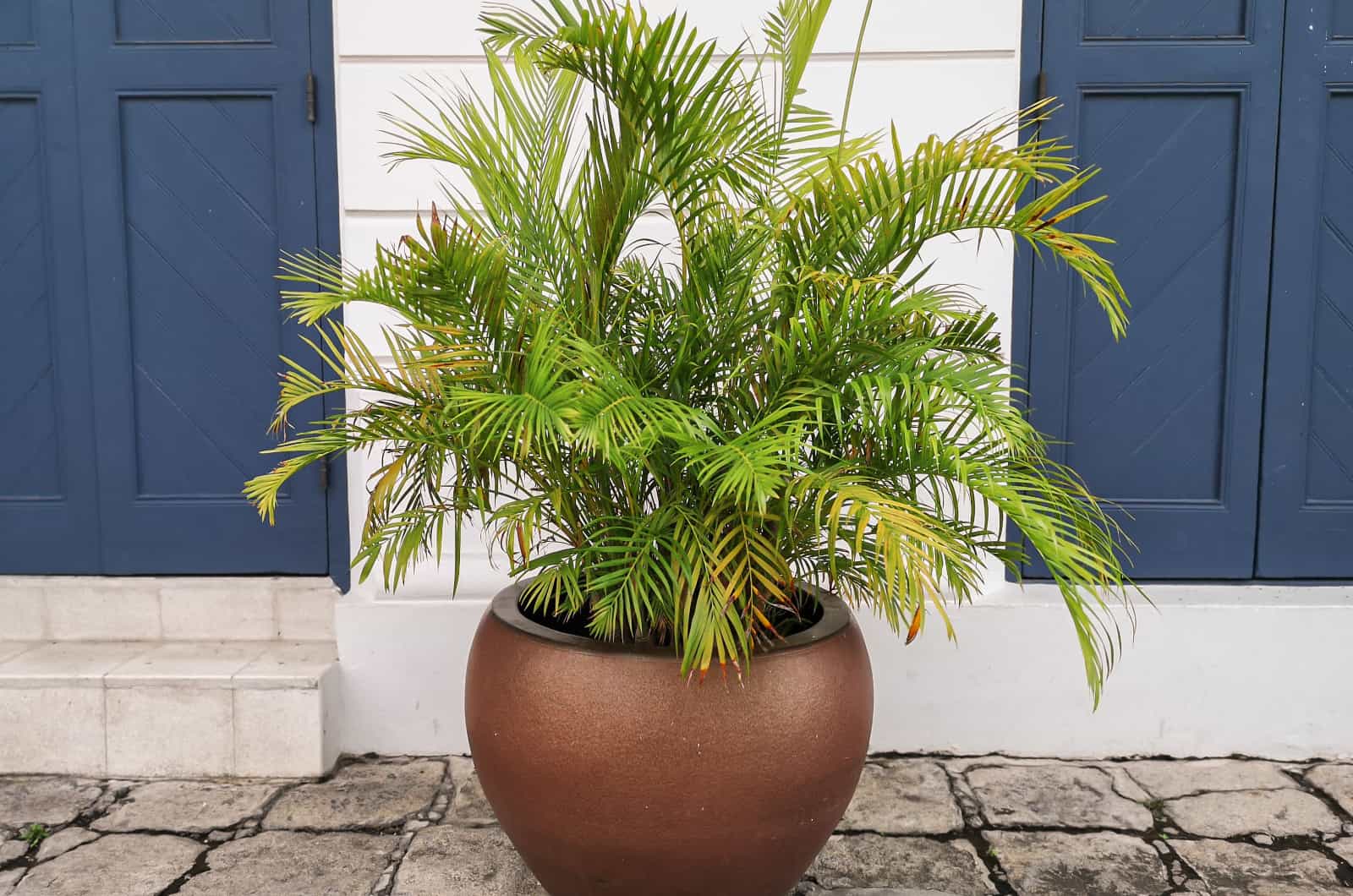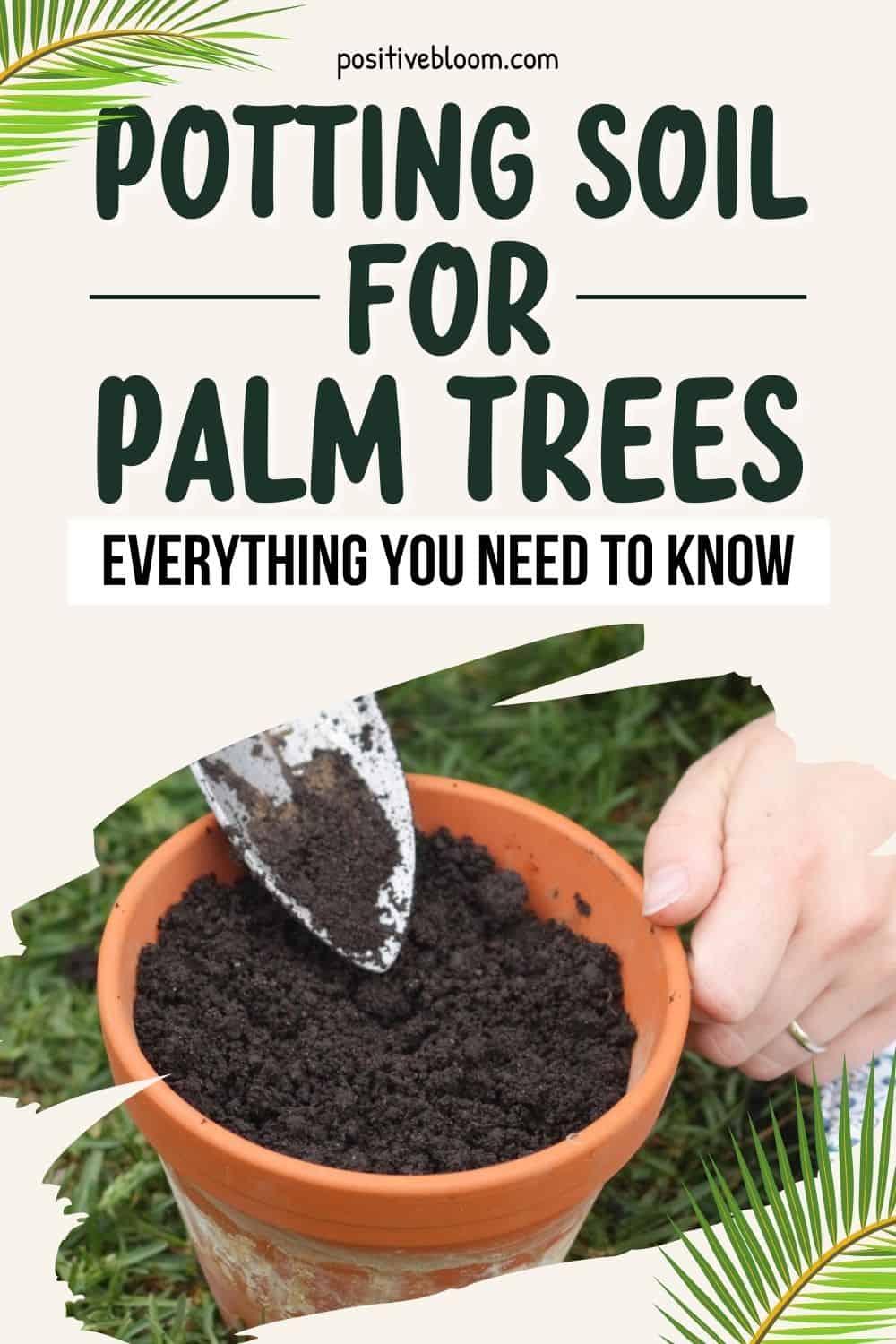Positive Bloom is an Amazon Associate and we earn from qualifying purchases through these links at no extra cost to you.
We always want to provide the best care for all our houseplants, and planting them in a good growing medium is crucial.
Palms have become a big hit in recent years, and if you own a Sago or Kentia palm you definitely need to plant it in a proper soil mix.
We decided to bring you our all-time favorite blends – and even reveal our recipe for making perfect potting soil for palm trees to help you out.
These plants have certain requirements for their growing substrates, and we’ll tackle all of those questions and more in this article.
Let’s get started!
5 Best Types Of Potting Soil For Palm Trees
Parlor palm and areca palm have their differences and similarities, but both varieties require well-draining and loose growing mediums.
We researched some potting mixes and found five that are ideal for palm trees in terms of drainage, aeration, and pH level.
Espoma Organic Cactus Mix For Cactus, Palm & Citrus
This mix is ideal for plants that need drainage, such as cactuses, palms, and citruses. It is entirely organic and even contains Myco-tone Mycorrhizae, which encourages the development of your plant’s root system, reduces stress caused by a lack of water and repotting (or transplantation), and increases water uptake.
Myco-tone is a mix of ecto and endo Mycorrhizae, which also increases the utilization of fertilizer and improves nutrient absorption.
This potting mix has the perfect ratio of humus, perlite, and sphagnum peat moss, a combination that improves drainage and aeration.
[table id=216 /]
Miracle-Gro Sphagnum Peat Moss
Miracle-gro is probably the most famous brand of soil and fertilizer on the market, and for good reason.
This particular product provides excellent drainage and enough nutrients for your potted palm trees and in-ground plants alike.
Sphagnum peat moss is one of the essential ingredients that makes the soil looser which helps your palm spread the roots more easily.
It is ideal for both outdoor and indoor palms, and you won’t have to water them frequently since moss retains moisture without water-clogging and compacting the soil.
Mix this product with regular potting soil, a bit of sand, and pumice or perlite to improve aeration and drainage and give your plant everything it needs.
This product is simple to use and even comes with a short manual on the back to help you plant your palms correctly and reduce transplant shock. The instructions also contain a care guide for exactly what your plants need.
The only downside is that it can arrive infested with gnats, spiders, and other pests, so inspect the soil thoroughly before planting. If you notice spider eggs in the soil, you should remove them.
[table id=219 /]
Fatplants San Diego Premium Cacti And Succulent Potting Mix
This soil mixture is perfect for all palm species, whether you own a fan palm, majesty palm, or windmill palm.
It is suitable for both indoor and outdoor use, so you won’t have to experiment with different soils to find the perfect one for palms that prefer growing in outside containers.
Fatplants potting mix is enriched with slow-release nutrients, so you won’t even have to fertilize your palms or add additional organic matter to the pot.
One of the best things about this blend is its balanced pH, so you won’t have to add any dolomite limestone or acidifying ingredients to ensure the proper pH level.
The most important thing about this soil is its excellent drainage. When planting palm trees, you need to make sure that the medium drains well because you don’t want to risk root rot and other fungal diseases.
[table id=217 /]
Jessie Mae Air Cleaning Plant Soil
Jessie Mae air cleaning plant soil is an ideal mix for all sorts of tropical plants, including palm trees. It has good drainage and is aerated, so it will keep your plants’ roots safe.
It is light and loose and contains a fair amount of perlite, which only contributes to proper drainage and aeration. This material improves air circulation and significantly decreases the possibility of root rot.
And yet, the mix also provides water retention, so you won’t have to irrigate your palms every day to stop them from dehydrating.
This potting mix also has a pH level ideal for your palms, and will ensure the best nutrient absorption possible.
I’m all about organic materials, and this soil is of 100% natural origin and completely chemical free. It’s safe for your plants and animals, so you won’t have to rush to a vet if your animal eats some.
But this doesn’t mean you should let your pets eat it because pesticides and fertilizers in the soil are dangerous if ingested in large quantities.
[table id=218 /]
Noot Organic Indoor Plant Soilless Potting Mix
This soilless mix is adored by palm trees. It contains coconut coir, chips, and husk mixed with perlite to provide the best drainage and aeration possible for plants that love air circulation around their roots.
It is already enriched with plant food so you don’t have to worry about feeding your plants, and the resealable package only makes storage simpler.
Not all bacteria and fungi are hostile, and this brand has found a way to utilize friendly fungi and bacteria that benefit root growth and development.
It is ideal for all growth stages, so you won’t have to buy different potting mixes when your plant enters the vegetative growth stage, starts blooming, etc.
One of the things I love most about this soil is that it’s completely organic and pet-friendly, and if you detect a bad smell coming from the package, you should just unseal the bag and leave it outdoors overnight.
The unpleasant smell doesn’t mean something’s wrong with the mix, it just happens when there isn’t enough oxygen.
The only thing is that it may arrive with some gnats in it, but that shouldn’t be too much of a bother – just make sure to remove all of them before potting your plant.
Finally, this soilless mix doesn’t retain moisture very well, so you should add some peat moss so you don’t have to water your plants every day.
[table id=220 /]
Soil Requirements Of Palm Trees
Purchasing a suitable growing medium is one thing, but understanding why it works for your plant is also very important to know.
You cannot simply plant your palms in garden soil and expect beautiful green fronds to appear. These plants need a specific substrate that is well-draining and aerated.
You should also pay close attention to the pH level of the soil. Palm trees prefer slightly acidic mediums, and your plant will not be happy if the pH is above 7.5.
These plants cannot absorb nutrients in alkaline soils and will suffer from a nutrient deficiency if you don’t address this issue.
You can read more about these requirements below.
Good Drainage And Aeration
Good drainage and aeration are crucial for healthy palm trees, especially if you live in a humid climate like Florida where it takes much longer for the soil to dry out.
They are native to the tropics and thrive in sandy soils, not heavy clay, so you need to find a way to mimic those conditions.
Thankfully, you can improve drainage and aeration by adding perlite to the potting medium or placing small rocks or gravel at the bottom of the container.
You can easily avoid clay soils when growing potted plants, but if you plan on growing a coconut palm (which is a textbook outdoor plant), you should amend the growing medium with some loam-based compost and sand to improve drainage.
One of the key things is to get a pot with drainage holes in the bottom so the excess water can seep right through.
Good palm soil is not just about drainage – it needs water retention as well. It will make your job a lot easier because you won’t have to water your plants. Peat moss is the most popular ingredient that improves moisture retention, but vermiculite is just as good. You can combine them both, just don’t add too much.
Soil pH
It’s important to keep soil pH in mind when planting your palm trees. These plants prefer moderately acidic to slightly alkaline mediums with a pH between 5.5-7.5.
Of course, it depends on the variety of your palm, so you should research its needs beforehand.
There’s no need for you to spend your days thinking about whether the pH is suitable for your plant, you can simply get one of these soil test kits to find out once and for all.
If you need to increase the acidity of the soil, you can add some acidifying liquids such as lemon juice or vinegar, but don’t add too much. You can dissolve one cup of vinegar in a gallon of water and occasionally irrigate your palm trees with this solution.
Compost and leaf mold can also lower the pH level of the soil, but they will only make it neutral or slightly less alkaline so you need to use some stronger stuff.
Sulfur is another efficient way of lowering alkalinity, but it works quite slowly.
If something goes terribly wrong and your soil becomes very acidic, you should increase the pH level as soon as possible before your plants start dying.
The best way to lower the acidity of the substrate is by adding dolomite limestone, which is rich in calcium and magnesium and also contains other minerals like iron and manganese.
Calcium is essential for cell formation; magnesium and iron are necessary for the synthesis of chlorophyll, without which photosynthesis wouldn’t be possible, and manganese supports the plant’s metabolic functions.
Dolomite contributes to the overall plant health and not just soil pH level.
Tips To Prevent Nutrient Deficiency
Even the best soil for palm trees will become nutrient deficient simply because well-draining mediums cannot retain minerals and organic matter as well as heavy soils.
You can always battle nutrient deficiency by fertilizing your palm trees more often, but if you want to avoid that or you simply cannot keep track of the last time you fed your plants, you should prevent draining nutrients in the first place.
Improving nutrient retention is closely connected to water-retention, but they aren’t the same and we want to prevent nutrient deficiency and keep the soil well-draining.
To counter the shortage of nutrients, growers have come up with some soil amendments to help their plants thrive.
I’ve had friends who love adding topsoil to their palm tree potting mix simply because it improves water retention. Of course, it’s important not to use too much because that can lead to some other issues, and you’ll be dealing with yellow palm leaves before you know it.
You can also add bone meal to introduce more nitrogen to the soil, or even nitrolized redwood shavings.
I personally love humus because it gives your plant everything it needs. However, it may prove to be too water-retentive so you should also add some pumice, perlite, or sand.
How To Make Soil Mix For Palm Trees
Below you will find a recipe for a palm tree growing medium that will meet all your plant’s requirements.
But first, let’s get one thing straight!
Even though these plants need well-draining soil to thrive, that doesn’t mean stripping it of all the ingredients that retain water.
Therefore, you must make sure to add some topsoil, peat moss, vermiculite, or humus. You can use compost if you don’t have humus, but it won’t improve the retention of nutrients as much.
However, too many water-retentive materials can lead to overwatered palm trees, so you shouldn’t be too generous when adding them.
Of course, substrates without materials that improve drainage won’t provide your plant with the care it needs, so add some redwood shavings, sand, coco coir, bark, etc.
You should also add perlite or pumice to make the soil looser and improve aeration because palm roots need room to grow.
Now that you know which ingredients you need, it’s time to take a look at the recipe. Just remember this: you don’t have to use all the materials listed above – if you don’t have pumice you can just use perlite instead.
Palm Soil Recipe
The critical thing is to balance the ingredients to come up with the perfect blend for your palm trees.
We like to mix 10% topsoil, sand (preferably horticultural or builder’s sand), pumice, and redwood shavings, and 30% peat moss and perlite.
This soil mixture will ensure both good drainage and water retention, so you won’t have to constantly water your palm trees.
However, you can always make simpler recipes and with fewer ingredients with some experimentation.
For instance, mixing 40% peat moss and perlite with 10% topsoil and sand will give you similar results as the substrate from above.
Some even use only equal parts perlite and moss, but this is more of a seed-starting substrate than a palm soil.
One of the best ways of preserving moisture is by mulching your palm tree. You can use compost, wood shavings or chips, or even pine needles as mulch; the only requirement is not to place it right at the plant’s base as it may trap moisture inside and lead to root rot.
Mulching your outdoor palms is also a great way of preventing weed growth, so you shouldn’t miss an opportunity to reduce the amount of time and work you have to invest in this plant.
Pro tip: when transplanting your palm tree outside, don’t remove the potting mix around the root ball to lower the possibility of transplant shock and help your plant recover faster.
Should You Fertilize Palm Trees?
Good palm care doesn’t just include getting a suitable growing medium – plant food and pruning are also important, among some other requirements like lighting and watering.
You should fertilize your palm trees 1-4 times a year depending on the brand of fertilizer and the region in which you live. For instance, palm trees in Florida can be fertilized up to four times a year.
Some fertilizers are slow-release and can supply your plant with nutrients for 3-6 months, so make sure you always follow the instructions on the package.
The good news is that there are palm fertilizers you can use to give your plants the best care possible.
There are many good fertilizers out there, but I honestly always try to get spikes as they are easy to use, reliable, and they keep your plants happy for at least three months. These are the fertilizer spikes I used when I grew indoor palm trees:
I always say it’s better to know your options, so you should try different fertilizers that fit your climate and soil chemistry perfectly. For instance, if your garden soil is already rich in some minerals, you don’t have to use a fertilizer rich in that specific nutrient.
Although fertilizer sticks are amazing, they’re not suitable for the palm trees that you grow in your garden. However, the fertilizer below is specialized for palm trees, and you can use it for your outdoor plants:
The Cascade palm care guide, or any other palm tree care guide, is straightforward, but you need to meet its soil and fertilizer requirements. There are some amazing products, you just have to choose the right product for your plant and region.
Frequently Asked Questions
We have answered some of the crucial questions about growing mediums for palm trees, but there are still some questions left that may widen your knowledge and improve your gardening skills.
We selected two of the questions, the answers to which may help your palms flourish.
Can you use regular potting soil for palm trees?
Regular potting soil won’t kill your palm, but the plant won’t thrive in it either.
These mediums are somewhat heavy and aren’t draining enough for palm trees to flourish in them.
But if you have a bag of this substrate at home, you can use it – just make sure to add some perlite, pumice, peat moss, and sand to make it more draining.
What compost should you use for palm trees?
Outdoor palms planted in the ground can benefit from any kind of compost because nature will kill the harmful fungi and bacteria that can spread in it.
That said, you shouldn’t use compost for indoor plants because it can retain too much moisture and contain many pathogenic organisms.
To Sum Up
The intention of this article was not to present the best type of potting soil for palm trees, simply because there is no such thing.
We showed you some great varieties for you to choose from, it all depends on your plant’s needs.
Palm trees need acidic, aerated, and well-draining soils, and if you don’t feel like buying a new bag of soil every couple of days you can make your own! We included two recipes that have worked well in the past.
Finally, no care guide is complete without a portion of proper plant food, so we presented two fertilizers great for indoor and outdoor palms.
We wish you good luck with planting and repotting your palm trees!
Until next time!
Like this post? Share or pin it for later!






